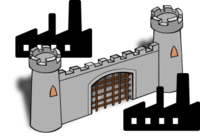Mobility barriers
| Mobility barriers |
|---|
| See also |
Mobility barriers are difficulties of moving the company from one strategic group to another. Because of them company is not competing with competitors with similar market profiles, but with those that sell products in the same price and quality group. Study of intra-industry mobility barriers is of particular importance to predicting the development of the sector and potential changes in the competition.
Low mobility barriers
- means that it is easy to move company from one to another strategic group,
- the least attractive sector groups can be a threat to other groups.
High mobility barriers
- means the stability of the structure of competition and security within the group,
- strategic groups protected by high barriers to mobility have good conditions for development.
Security in the industry mobility
The issue of security within the industry can be partly explained by the symmetry of mobility barriers:
- symmetric barriers to intra-industry mobility - moving to another group is just a matter of investment,
- asymmetrical barriers to intra-industry mobility - companies must have specific skills.
Summing up, the situation for the strategic group is most advantageous when it has high barriers to entry into the group and these barriers are asymmetric.
In each sector there are not only barriers to entry, but also the ability to retort on the part of its current participants and competitors.
The effects of the existence of mobility barriers
Entry barriers restrict newcomers and threaten them. They lie mainly in the cost and time. By analysing them, you should take into account following elements:
- phenomenon of economies of scale, which means that in order to obtain competitively low cost, company must have the potential to achieve the right size for all it's services, i.e. production, marketing, research and development. However, in some cases, the cost advantage is not dependent on the production capacity, but on other factors.
- transfer costs,
- access to distribution networks,
- product differentiation.
Discouraging factor for entry into industry
Ability to retort is important factor if there are weaker barriers to entry and the more likely newcomers can enter to the sector. Following factors can discourage attempts of newcomers entry to industry:
- existence of a tradition of maintaining close and cordial ties between the professional actors of the industry,
- cultivation of professional tradition, which also favour the mobilization of forces against new competition.
- ability of enterprises to mobilize their own resources,
- existing cost structure and profit margins.
Types of entry barriers
Barriers to entry and barriers to exit are basic concepts in management strategy. They identify obstacles which companies encounter going into a given segment of the market, or if they want to leave it. These barriers can be considered as an obstacle to the functioning of the free market, because they raise the cost (not just financial) of starting or ending business in given industry. The cause of creating such barriers is the desire to achieve competitive advantage by companies already present on a given market. They restrict unexpected competitive attack from new competitors, by imposing high cost of entry into the market.
The barriers to entry is a hindrance to competitors. Entry barriers can arise spontaneously (then we call them natural) or are the result of deliberate actions taken by companies operating in the given market.
Intensity of competition influence on market entry barriers
The height of barriers to entry, and thus the predictability and the intensity of competition in the market depends on many variables:
- the economies of scale of production (in conjunction with the experience curve),
- the capital requirements
- the power of product brands
- conversion costs - how much does it cost to change vendors of industrial goods on the market,
- access to distribution channels,
- access to technology,
- the government regulations (quotas, quantitative restrictions),
- the expected retaliation,
- price preventing market entry,
- experience,
- government policy.
Types of barriers to exit
Exit barriers are the costs associated with the decision of resignation of production. The costs of these decisions stem from specialization and assets involved in production, psychological barriers (inherent emotional) are also significant.
The more a given activity depends on specific technological assets, the higher are the exit barriers. The main exit barriers are:
- specialized resources (material, machines and employees)
- high fixed costs of stopping production (admission payments for employees)
- costs of providing spare parts for old products,
- emotional-attachment to own company (family tradition).
Exit barriers may be also distinguished as:
- economic (narrow specialization of assets or high fixed costs of exit),
- strategic (strong linkages and interdependency between different areas of activity),
- political and social (state intervention or pressure from trade unions),
- psychological (for many business leaders, who all his career tied to a specific area of production, it is extremely difficult to reconcile with the fact of leaving the industry and provide that information to employees, which often take it as a defeat).
References
- Bazzi, S. (2015). Firm Entry Barriers, Growth Constraints, and Job Creation: Theory and Evidence from Brazil.
- Caves, R. E., & Porter, M. E. (1977). From entry barriers to mobility barriers: Conjectural decisions and contrived deterrence to new competition. The Quarterly Journal of Economics, 241-261.
- Demsetz, H. (1982). Barriers to entry. The American Economic Review, 72(1), 47-57.
- Peteraf, M. A. (1993). Intra‐industry structure and the response toward rivals. Managerial and Decision Economics, 14(6), 519-528.
- Porter, M. E. (1976). Please note location of nearest exit: Exit barriers and planning. California Management Review, 19(2), 21-33.
Author: Karolina Orzeł, Joanna Grych
